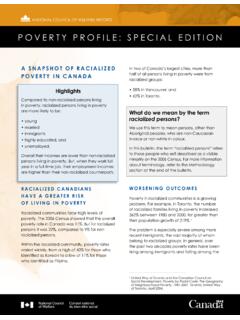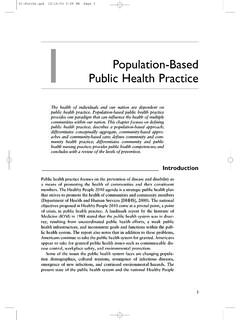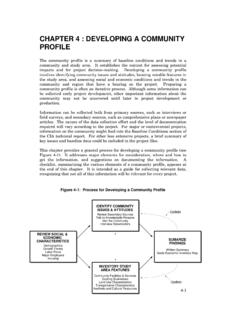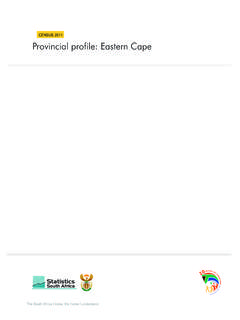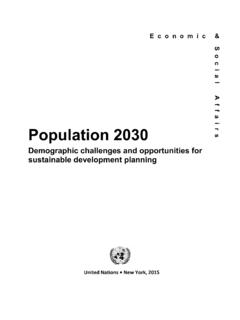Transcription of Republic of the Philippines National Urban Assessment
1 ASIAN DEVELOPMENT BANKR epublic of the Philippines National Urban AssessmentThe Urban Operational Plan (UOP) 2012 2020 of the Asian Development Bank (ADB) supports ADB developing member countries (DMCs) in expanding their Urban economies, improving environmental sustainability, and making pro-poor investments through a 3E approach (Economy, Environment, and Equity). This case study on the Philippines is based on thematic areas of the National Urban Sustainability Assessment framework for developing strategic policy options and targeted investments in the Urban sector.
2 This publication shows how the framework acts as a tool for conducting rapid Urban assessments at both National and Urban region levels for DMCs. ISBN 978-92-9254-486-7 About the Asian Development BankADB s vision is an Asia and Pacific region free of poverty. Its mission is to help its developing member countries reduce poverty and improve the quality of life of their people. Despite the region s many successes, it remains home to approximately two-thirds of the world s poor: billion people who live on less than $2 a day, with 733 million struggling on less than $ a day.
3 ADB is committed to reducing poverty through inclusive economic growth, environmentally sustainable growth, and regional in Manila, ADB is owned by 67 members, including 48 from the region. Its main instruments for helping its developing member countries are policy dialogue, loans, equity investments, guarantees, grants, and technical Development BAnk6 ADB Avenue, Mandaluyong City1550 Metro Manila, of the PhiliPPiNesNAtioNAl Urban AssessmeNtRP National Urban Assessment_COVER 18/19/2014 11:45:56 AMREPUBLIC OF THE Philippines National Urban ASSESSMENTASIAN DEVELOPMENT BANK 2014 Asian Development BankAll rights reserved.
4 Published in in the 978-92-9254-486-7 (Print), 978-92-9254-487-4 (e-ISBN)Publication Stock No. RPT146356 Cataloging-in-Publication Singru, Ramola and Michael Lindfield. Republic of the Philippines National Urban City, Philippines : Asian Development Bank, Urban development. 2. Philippines . 3. National Urban Assessment , strategy, and road maps. I. Asian Development views expressed in this publication are those of the authors and do not necessarily reflect the views and policies of the Asian Development Bank (ADB) or its Board of Governors or the governments they does not guarantee the accuracy of the data included in this publication and accepts no responsibility for any consequence of their making any designation of or reference to a particular territory or geographic area, or by using the term country in this document.
5 ADB does not intend to make any judgments as to the legal or other status of any territory or encourages printing or copying information exclusively for personal and noncommercial use with proper acknowledgment of ADB. Users are restricted from reselling, redistributing, or creating derivative works for commercial purposes without the express, written consent of :In this report, $ refers to US ADB Avenue, Mandaluyong City1550 Metro Manila, PhilippinesTel +63 2 632 4444 Fax +63 2 636 orders, please contact.
6 Public Information CenterFax +63 2 636 on recycled paperiiiContentsFigures, Charts, Tables, and Maps ivAcknowledgments viAbstract viiCurrency Equivalents viiAbbreviations viii1 Introduction 12 Country Profile 2 Location 2 Political History 3 Political System 4 Urbanization Profile 5 Governance and Urban Management Profile 15 Institutional Structures for Urban Development 15 Key Urban Development Framework 16 Key Urban Development Legislation 19 Urban Finance Matrix 21 Legislative and Regulatory Framework 24 Enabling Environment 24 Competitive Base: Economic Profile 30 Inclusive Base: Equity Profile 35 Green Base.
7 Environmental Profile 38 ADB and Development Partner Support in Urban Development 42 Capacity Development Needs Assessment 503 Urban Needs Assessment 56 Sector-Based Needs Assessment 564 Urban Strategy and Prioritization 67 National Strategy 67 Urban Sector Strategy 67 ADB Philippines Country Partnership Strategy 685 Urban Priorities 696 Policy and Programming 72 Strategic Urban Infrastructure Investment Plan 727 3E Targeted Investment Program 75 Urban Projects Formulated Based on 3E Assessment 75 Appendix 78 References 81ivFigures, Charts, Tables, and MapsFigures1 Integrated Sustainable Urban Development Framework 12 Urban and Rural population , 1990 2010 53 Total population Change 64 Total, Urban , and Rural population , 1995 2010 65 Annual Growth Rate of Urban population by Region, 1975 2000 76 population Density (persons/km2) vs.
8 Land Area by Region, 2010 87 Urbanization by Region, 2000 98 population Density and Area of Metropolitan Regions, Philippines , 2007 129 Ten Most Populous Cities in the Philippines , 1990 2007 1210 Net International Migration Rate, Philippines , 1990 2010 1311 Land Classification, 2009 14 Charts1 Institutional Structure for Delivering Urban Development 172 Functional Areas and Responsibilities for Urban Services 183 Philippines Urban Planning Framework: Tiers and Linkages 194 Urban Finance Matrix 215 Revenue Collections by Region, 2004 2009 226 Sources and Types of Income of Local Government Units 237 Internal Revenue Allotments by Region, 2005 2010 248 Ease of Starting a Business in the Philippines 289 Global Competitive Index 2810 Most Problematic Factors for Doing Business in Philippine Cities 2911 Ease of Dealing with Construction Permits in Philippine Cities 3012 Ease of Registering Property in Philippine Cities 3113 Foreign Direct Investments by Region.
9 1990 2010 3214 Gross Domestic Product by Region, 1995 2009 3315 International Tourism Performance 3416 Intra- Urban Inequalities Gini Coefficient 3517 Unemployment Rate, 1995 2010 3618 Urban Slum population 3719 Greenhouse Gas Emissions 4120 Carbon Dioxide Emissions in Transport and Power Sectors 4221 Total Number of Graduates by Degree Program, 1999 2012 5222 Use of Sanitation Facilities, 1990 2008 6023 Status of Energization by Region, 2009 6424 Electricity Generation and Consumption 6425 Average Retail Electricity Tariffs 65 Figures, Charts, Tables.
10 And Maps vTables1 Projected Levels of Urbanization82 Suggested Areas for Interventions along the 3E Approach of ADB Urban Operational Plan7333E Targeted Investment Priorities by Sector75A1 Indicative Investment Requirements of Basic Urban Services by Region78A2 Indicative Investment Requirements of the Basic Urban Services by Sector79A3 Proposed Financing Plan80 Maps1 Administrative Regions of the Philippines 22 Urban Settlements in the Philippines , 2010113 Cities Exposed to Multi-Hazards394 National Spatial Strategy and Priorities71viAcknowledgmentsWe gratefully acknowledge the discussions and input of our colleagues.










